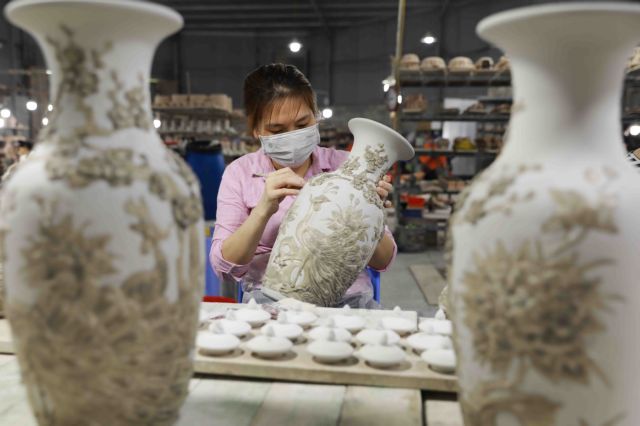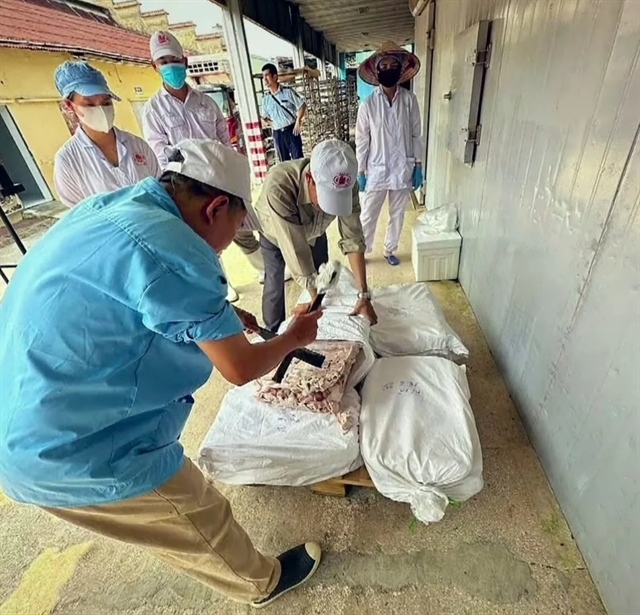 Opinion
Opinion


|
| Workers is painting on a ceramic product in Bát Tràng Traditional Pottery Village in Hà Nội. VNA/VNS Photo |
International friends highly appreciate Vietnamese handicraft products; however, aesthetic factors and product design skills are still weaknesses that need to be addressed to bring the products closer to life. Artist and handicraft expert Vũ Hy Thiều talks with Việt Nam News reporter Tố Như about this issue.
How do you evaluate the role of craft villages in economic development in general, and of Hà Nội in particular?
Currently, there are approximately 5,400 craft villages across the country, of which 2,000 are traditional craft villages recognised by state criteria, and 57 others are recognised as intangible cultural heritage.
The craft villages are mainly in the northern region. The five localities with craft villages that account for 60 per cent of total villages nationwide are Hà Nội, Thanh Hóa, Nghệ An, Hải Dương (now part of Hải Phòng City), Thái Bình (now part of Hưng Yên Province) and Bắc Ninh.
Products of the villages, especially of traditional handicraft villages, are a combination of cultural values and the skillfulness of artisans and craftsmen. The skillfulness and talent accumulated over many generations not only meet functional needs but also demonstrate cultural values and national spirit.
For hundreds of years, craft villages have not only preserved the quintessence of national culture but also contain values of natural landscapes, architecture or historical relics.
The names of crafts are closely associated with the names of villages, bearing a strong cultural imprint of a time, such as Phú Thọ conical hats, Đại Bái bronze, Vạn Phúc silk, Bát Tràng pottery and An Giang brocade.
The products of the craft village are diverse, with many types of eye-catching designs, good quality and competitive prices in domestic and foreign markets, such as garments, ceramics, weaving and embroidery, traditional lace, wood, construction, mechanical, agricultural and food processing products.
Craft villages are not only a space preserving culture and historic values, but also an important livelihood for villagers.
Craft villages create jobs for about 3.7 million employees with an average per capita income of VNĐ5 million (US$200) per month, as well as reaching export turnover of US$3.3 billion a year.
At present, more and more craft villages have become attractive tourism destinations to both domestic and international visitors, contributing to promoting Việt Nam and the image of Vietnamese people to international friends, creating motivation for local socio-economic development.
Hà Nội alone has 1,350 traditional craft villages, of which 337 have been recognised by the State.
The city is considered a cradle of traditional craft works that not only has great economic potential but also is a place preserving and spreading the national cultural identity for hundreds of years.
Hà Nội is also the only locality in the country that converges 47 out of 52 recognised traditional occupations, accounting for nearly 90 per cent of the total number of national traditional occupations. This is a special advantage for developing the export of products associated with the cultural industries in a period of deep international integration.
The ability to supply handicraft products from Hà Nội’s craft villages is currently assessed as relatively stable, with great potential for supplying the international market.
However, reality has also shown that the capacity to expand scale is still limited, especially in traditional handicraft product groups that require high technology and complex processes. Therefore, there needs to be a specific strategy for production organisation and technological innovation to improve competitiveness.
Product design is one of the very important factors for craft villages. What do you think about the works of artisans and craftsmen in recent times?
In some contests in designing handicraft products recently, some products had eye-catching designs, particularly pottery products, which showed the artistic skills of craftsmen.
However, such products are still not many. Most of the products are still in familiar shapes and workers just change decoration. This makes the products have low economic value.
For example, in the lacquered and gilded craft village, although the products are relatively good, both ceramic and lacquered-and-gilded products face the same issue that they are overly oriented toward traditional styles. The artisans seem to follow a worn path, producing familiar designs.
A set of altar wares entirely made from a single type of brown ceramic, when placed on an altar, results in a dull, monotonous setup due to the uniform brown colour and material. Altars usually feature a variety of items—some made from ceramics, some lacquered and gilded, and others cast in bronze. For instance, candleholders made of bronze are more valued, or a throne is typically lacquered and gilded—rarely, if ever, is it made from ceramics.
Another shortcoming of traditional ceramic decoration is that it tends to be overly intricate and complicated, whereas modern aesthetic trends lean towards minimalism. As a result, such products no longer suit contemporary household settings.
In the case of ceramics, wooden items, and lacquered-and-gilded objects, their large size remains an issue. They are heavy and difficult to transport. Oversized vases are ill-suited for most modern homes, especially those in apartment buildings with limited space. The question is how to create smaller, more compact and lightweight items that can fit into all types of spaces.
Additionally, it is important to differentiate between products meant for spiritual purposes, those used for home decoration, and those intended as gifts or souvenirs. When giving such items as gifts, attention must also be paid to whether the recipient can actually make use of them.
Artisans still face the disadvantage of chasing after complexity and grandiosity, resulting in large, heavy objects. A real issue is that many artisans suffer from a lack of ideas and direction. Even though their craftsmanship is excellent, the absence of clear orientation leads to waste. This is an area that needs reflection and improvement so that artisans can properly utilise their skills, thereby increasing the value of their products and making them more suitable for consumers.
How do you evaluate a combination of villages’ products?
Currently, craft villages are still far apart geographically, so co-ordination in a display space is possible, but combining them into the same product is a bit difficult.
Accordingly, ceramics can be combined with wooden furniture. For example, ceramic jars can use wooden bases, which will greatly enhance the product.
As for lacquer and gold leaf, it is almost independent. In the lacquer and gold leaf work, it is a combination of two crafts of sculpture, carving, lacquer and gold leaf, so it does not necessarily go with other crafts.
In my experience, a combination of craft products is good and artisans must guide the consumers to make the appropriate choice.
Could you tell more about a contest for handicraft gifts?
Currently, our handicrafts are quite diverse. However, handicraft items specifically made for gifts and souvenirs are severely lacking. In reality, although we hold many competitions, the directions are unclear, and the criteria are vague. As a result, most of our crafts do not yet have a distinct product line designed specifically for tourism or as gifts.
We are merely repurposing existing items to be used as gifts. This has led to some rather funny situations. For example, in one case, a ceramic item was gifted to a foreign guest, and upon receiving it, they nearly fell over because the ceramic vase weighed more than 10kg.
Clearly, we are still lacking products tailored for the tourism sector. Therefore, it is necessary to provide guidance for some artisans to specialise in creating products for tourism.
In Japan, for instance, there are animal figurines made of ceramic no larger than a fingertip, placed on small wooden bases, which are extremely popular among tourists.
Meanwhile, our artisans tend to think only of producing large, oversized pieces, which I believe are not effective as gift items. VNS




